Regulatory Mechanisms of Plant Growth-Promoting Bacteria in Alleviating Microplastic and Heavy Metal Combined Pollution: Insights from Plant Growth and Metagenomic Analysis
Abstract
1. Introduction
2. Materials and Methods
2.1. Experimental Materials
2.2. Pot Experiment
2.3. Determination of Cd Content and Soil Properties
2.4. Metagenomic Analysis
2.5. Data Analysis
3. Results
3.1. Effects of Different Treatments on Sorghum Growth
3.2. Effects of Different Treatments on Cd Accumulation in Sorghum
3.3. Effects of Different Treatments on the Physicochemical Properties of Sorghum Rhizosphere Soil
3.4. Effects of Inoculated Strains on Bacterial Community Composition
3.5. Functional Profiling of Metagenomes
3.5.1. KEGG Functional Annotation
3.5.2. Functional Differences in Rhizosphere Soil Microbial Communities
3.5.3. Differences in Nitrogen and Phosphorus Cycling Functional Genes
4. Discussion
5. Conclusions
Supplementary Materials
Author Contributions
Funding
Data Availability Statement
Acknowledgments
Conflicts of Interest
References
- Genchi, G.; Sinicropi, M.S.; Lauria, G.; Carocci, A.; Catalano, A. The Effects of Cadmium Toxicity. Int. J. Environ. Res. Public Health 2020, 17, 3782. [Google Scholar] [CrossRef]
- Charkiewicz, A.E.; Omeljaniuk, W.J.; Nowak, K.; Garley, M.; Nikliński, J. Cadmium Toxicity and Health Effects—A Brief Summary. Molecules 2023, 28, 6620. [Google Scholar] [CrossRef]
- Yang, Q.; Li, Z.; Lu, X.; Duan, Q.; Huang, L.; Bi, J. A review of soil heavy metal pollution from industrial and agricultural regions in China: Pollution and risk assessment. Sci. Total Environ. 2018, 642, 690–700. [Google Scholar] [CrossRef]
- Li, J.-T.; Baker, A.J.M.; Ye, Z.-H.; Wang, H.-B.; Shu, W.-S. Phytoextraction of Cd-Contaminated Soils: Current Status and Future Challenges. Crit. Rev. Environ. Sci. Technol. 2012, 42, 2113–2152. [Google Scholar] [CrossRef]
- de Souza Machado, A.A.; Lau, C.W.; Till, J.; Kloas, W.; Lehmann, A.; Becker, R.; Rillig, M.C. Impacts of Microplastics on the Soil Biophysical Environment. Environ. Sci. Technol. 2018, 52, 9656–9665. [Google Scholar] [CrossRef] [PubMed]
- Hale, R.C.; Seeley, M.E.; La Guardia, M.J.; Mai, L.; Zeng, E.Y. A Global Perspective on Microplastics. J. Geophys. Res. Ocean. 2020, 125, e2018JC014719. [Google Scholar] [CrossRef]
- Yang, L.; Zhang, Y.; Kang, S.; Wang, Z.; Wu, C. Microplastics in soil: A review on methods, occurrence, sources, and potential risk. Sci. Total Environ. 2021, 780, 146546. [Google Scholar] [CrossRef]
- Weber, C.J.; Kundel, D.; Fliessbach, A.; Bünemann, E.K.; Bigalke, M. Baseline levels of microplastics in agricultural soils obscure the effects of additional microplastics from recycled fertilizers. Microplastics Nanoplastics 2025, 5, 30. [Google Scholar] [CrossRef]
- Fang, S.; Hua, C.; Yang, J.; Liu, F.; Wang, L.; Wu, D.; Ren, L. Combined pollution of soil by heavy metals, microplastics, and pesticides: Mechanisms and anthropogenic drivers. J. Hazard. Mater. 2025, 485, 136812. [Google Scholar] [CrossRef] [PubMed]
- Cao, Y.; Zhao, M.; Ma, X.; Song, Y.; Zuo, S.; Li, H.; Deng, W. A critical review on the interactions of microplastics with heavy metals: Mechanism and their combined effect on organisms and humans. Sci. Total Environ. 2021, 788, 147620. [Google Scholar] [CrossRef]
- Wu, X.; Lin, L.; Lin, Z.; Deng, X.; Li, W.; He, T.; Zhang, J.; Wang, Y.; Chen, L.; Lei, Z.; et al. Influencing mechanisms of microplastics existence on soil heavy metals accumulated by plants. Sci. Total Environ. 2024, 926, 171878. [Google Scholar] [CrossRef]
- Wang, F.; Zhang, X.; Zhang, S.; Zhang, S.; Sun, Y. Interactions of microplastics and cadmium on plant growth and arbuscular mycorrhizal fungal communities in an agricultural soil. Chemosphere 2020, 254, 126791. [Google Scholar] [CrossRef]
- Feng, X.; Wang, Q.; Sun, Y.; Zhang, S.; Wang, F. Microplastics change soil properties, heavy metal availability and bacterial community in a Pb-Zn-contaminated soil. J. Hazard. Mater. 2022, 424, 127364. [Google Scholar] [CrossRef] [PubMed]
- Lugtenberg, B.; Kamilova, F. Plant-Growth-Promoting Rhizobacteria. Annu. Rev. Microbiol. 2009, 63, 541–556. [Google Scholar] [CrossRef]
- Ramakrishna, W.; Yadav, R.; Li, K. Plant growth promoting bacteria in agriculture: Two sides of a coin. Appl. Soil Ecol. 2019, 138, 10–18. [Google Scholar] [CrossRef]
- Gómez-Godínez, L.J.; Aguirre-Noyola, J.L.; Martínez-Romero, E.; Arteaga-Garibay, R.I.; Ireta-Moreno, J.; Ruvalcaba-Gómez, J.M. A Look at Plant-Growth-Promoting Bacteria. Plants 2023, 12, 1668. [Google Scholar] [CrossRef]
- Liu, A.; Wang, W.; Chen, X.; Zheng, X.; Fu, W.; Wang, G.; Ji, J.; Guan, C. Phytoremediation of DEHP and heavy metals co-contaminated soil by rice assisted with a PGPR consortium: Insights into the regulation of ion homeostasis, improvement of photosynthesis and enrichment of beneficial bacteria in rhizosphere soil. Environ. Pollut. 2022, 314, 120303. [Google Scholar] [CrossRef] [PubMed]
- Chen, F.; Tan, M.; Ma, J.; Zhang, S.; Li, G.; Qu, J. Efficient remediation of PAH-metal co-contaminated soil using microbial-plant combination: A greenhouse study. J. Hazard. Mater. 2016, 302, 250–261. [Google Scholar] [CrossRef]
- Liu, Y.-Q.; Chen, Y.; Li, Y.-Y.; Ding, C.-Y.; Li, B.-L.; Han, H.; Chen, Z.-J. Plant growth-promoting bacteria improve the Cd phytoremediation efficiency of soils contaminated with PE–Cd complex pollution by influencing the rhizosphere microbiome of sorghum. J. Hazard. Mater. 2024, 469, 134085. [Google Scholar] [CrossRef]
- Zhang, Y.; Zhao, S.-Y.; Zhang, R.-H.; Li, B.L.; Li, Y.-Y.; Han, H.; Duan, P.-F.; Chen, Z.-J. Screening of plant growth-promoting rhizobacteria helps alleviate the joint toxicity of PVC+Cd pollution in sorghum plants. Environ. Pollut. 2024, 355, 124201. [Google Scholar] [CrossRef]
- Zhang, Y.; Chen, Y.; Jiao, R.-Q.; Gao, S.-S.; Li, B.L.; Li, Y.-Y.; Han, H.; Chen, Z.-J. Beneficial microbial consortia effectively alleviated plant stress caused by the synergistic toxicity of microplastics and cadmium. Ind. Crops Prod. 2025, 225, 120479. [Google Scholar] [CrossRef]
- Berendsen, R.L.; Pieterse, C.M.J.; Bakker, P.A.H.M. The rhizosphere microbiome and plant health. Trends Plant Sci. 2012, 17, 478–486. [Google Scholar] [CrossRef]
- Spanogiannopoulos, P.; Bess, E.N.; Carmody, R.N.; Turnbaugh, P.J. The microbial pharmacists within us: A metagenomic view of xenobiotic metabolism. Nat. Rev. Microbiol. 2016, 14, 273–287. [Google Scholar] [CrossRef]
- Daniel, R. The metagenomics of soil. Nat. Rev. Microbiol. 2005, 3, 470–478. [Google Scholar] [CrossRef]
- Wu, Z.; Kang, L.; Yang, Y.; Shi, Z.; Lyu, H.; Ma, X. Synergistic effects of polyethylene microplastics and cadmium on soil bacterial communities and metabolic functions. J. Environ. Chem. Eng. 2025, 13, 116889. [Google Scholar] [CrossRef]
- Bell, T.H.; Joly, S.; Pitre, F.E.; Yergeau, E. Increasing phytoremediation efficiency and reliability using novel omics approaches. Trends Biotechnol. 2014, 32, 271–280. [Google Scholar] [CrossRef]
- Chettri, D.; Verma, A.K.; Chirania, M.; Verma, A.K. Metagenomic approaches in bioremediation of environmental pollutants. Environ. Pollut. 2024, 363, 125297. [Google Scholar] [CrossRef]
- Wang, Z.; Li, W.; Li, W.; Yang, W.; Jing, S. Effects of microplastics on the water characteristic curve of soils with different textures. Chemosphere 2023, 317, 137762. [Google Scholar] [CrossRef] [PubMed]
- Yu, Y.; Li, X.; Fan, H.; Li, Y.; Yao, H. Dose effect of polyethylene microplastics on nitrous oxide emissions from paddy soils cultivated for different periods. J. Hazard. Mater. 2023, 453, 131445. [Google Scholar] [CrossRef] [PubMed]
- Zhang, H.; Zhu, W.; Zhang, J.; Müller, C.; Wang, L.; Jiang, R. Enhancing soil gross nitrogen transformation through regulation of microbial nitrogen-cycling genes by biodegradable microplastics. J. Hazard. Mater. 2024, 478, 135528. [Google Scholar] [CrossRef] [PubMed]
- Lin, H.; Cui, G.; Jin, Q.; Liu, J.; Dong, Y. Effects of microplastics on the uptake and accumulation of heavy metals in plants: A review. J. Environ. Chem. Eng. 2024, 12, 111812. [Google Scholar] [CrossRef]
- Chen, L.; Chang, N.; Qiu, T.; Wang, N.; Cui, Q.; Zhao, S.; Huang, F.; Chen, H.; Zeng, Y.; Dong, F.; et al. Meta-analysis of impacts of microplastics on plant heavy metal(loid) accumulation. Environ. Pollut. 2024, 348, 123787. [Google Scholar] [CrossRef] [PubMed]
- Duan, L.-Y.; Zhang, Y.; Li, Y.-Y.; Li, X.-Q.; Liu, Y.-Q.; Li, B.L.; Ding, C.-Y.; Ren, X.-M.; Duan, P.-F.; Han, H.; et al. Effects of combined microplastic and cadmium pollution on sorghum growth, Cd accumulation, and rhizosphere microbial functions. Ecotoxicol. Environ. Saf. 2024, 277, 116380. [Google Scholar] [CrossRef]
- Kumar, R.; Ivy, N.; Bhattacharya, S.; Dey, A.; Sharma, P. Coupled effects of microplastics and heavy metals on plants: Uptake, bioaccumulation, and environmental health perspectives. Sci. Total Environ. 2022, 836, 155619. [Google Scholar] [CrossRef] [PubMed]
- Chen, Z.; Carter, L.J.; Banwart, S.A.; Kay, P. Microplastics in Soil–Plant Systems: Current Knowledge, Research Gaps, and Future Directions for Agricultural Sustainability. Agronomy 2025, 15, 1519. [Google Scholar] [CrossRef]
- Yaashikaa, P.R.; Kumar, P.S.; Jeevanantham, S.; Saravanan, R. A review on bioremediation approach for heavy metal detoxification and accumulation in plants. Environ. Pollut. 2022, 301, 119035. [Google Scholar] [CrossRef] [PubMed]
- Rashid, A.; Schutte, B.J.; Ulery, A.; Deyholos, M.K.; Sanogo, S.; Lehnhoff, E.A.; Beck, L. Heavy Metal Contamination in Agricultural Soil: Environmental Pollutants Affecting Crop Health. Agronomy 2023, 13, 1521. [Google Scholar] [CrossRef]
- Kajal, S.; Thakur, S. Coexistence of microplastics and heavy metals in soil: Occurrence, transport, key interactions and effect on plants. Environ. Res. 2024, 262, 119960. [Google Scholar] [CrossRef]
- Han, Y.; Teng, Y.; Wang, X.; Wen, D.; Gao, P.; Yan, D.; Yang, N. Biodegradable PBAT microplastics adversely affect pakchoi (Brassica chinensis L.) growth and the rhizosphere ecology: Focusing on rhizosphere microbial community composition, element metabolic potential, and root exudates. Sci. Total Environ. 2023, 912, 169048. [Google Scholar] [CrossRef]
- Pu, Z.-t.; Wang, D.-d.; Song, W.-x.; Wang, C.; Li, Z.-y.; Chen, Y.-l.; Shimozono, T.; Yang, Z.-m.; Tian, Y.-q.; Xie, Z.-h. The impact of arbuscular mycorrhizal fungi and endophytic bacteria on peanuts under the combined pollution of cadmium and microplastics. J. Hazard. Mater. 2024, 469, 133934. [Google Scholar] [CrossRef]
- Liu, Y.-Q.; Chen, Y.; Ren, X.-M.; Li, Y.-Y.; Zhang, Y.-J.; Zhang, H.; Han, H.; Chen, Z.-J. Plant growth-promoting bacteria modulate gene expression and induce antioxidant tolerance to alleviate synergistic toxicity from combined microplastic and Cd pollution in sorghum. Ecotoxicol. Environ. Saf. 2023, 264, 115439. [Google Scholar] [CrossRef]
- Rolón-Cárdenas, G.A.; Arvizu-Gómez, J.L.; Soria-Guerra, R.E.; Pacheco-Aguilar, J.R.; Alatorre-Cobos, F.; Hernández-Morales, A. The role of auxins and auxin-producing bacteria in the tolerance and accumulation of cadmium by plants. Environ. Geochem. Health 2022, 44, 3743–3764. [Google Scholar] [CrossRef]
- Carlos, M.-H.J.; Stefani, P.-V.Y.; Janette, A.-M.; Melani, M.-S.S.; Gabriela, P.-O. Assessing the effects of heavy metals in ACC deaminase and IAA production on plant growth-promoting bacteria. Microbiol. Res. 2016, 188–189, 53–61. [Google Scholar] [CrossRef] [PubMed]
- Rostami, S.; Azhdarpoor, A. The application of plant growth regulators to improve phytoremediation of contaminated soils: A review. Chemosphere 2019, 220, 818–827. [Google Scholar] [CrossRef] [PubMed]
- García de Salamone, I.E.; Funes, J.M.; Di Salvo, L.P.; Escobar-Ortega, J.S.; D’Auria, F.; Ferrando, L.; Fernandez-Scavino, A. Inoculation of paddy rice with Azospirillum brasilense and Pseudomonas fluorescens: Impact of plant genotypes on rhizosphere microbial communities and field crop production. Appl. Soil Ecol. 2012, 61, 196–204. [Google Scholar] [CrossRef]
- Cheng, Y.; Ma, Y. Plant growth-promoting bacteria reshape rhizosphere microbial networks and biochemical properties to drive sustainable Zea mays growth. Appl. Soil Ecol. 2025, 213, 106275. [Google Scholar] [CrossRef]
- Habibollahi, M.H.; Baghizadeh, A.; Sabokbar, A.; Sharafi, K. Isolation and characterization of copper and cadmium resistant bacteria from industrial wastewaters and evaluating the biosorption of selected bacteria. Desalination Water Treat. 2017, 93, 139–144. [Google Scholar] [CrossRef]
- Al-Huqail, A.A.; El-Bondkly, A.M.A. Improvement of Zea mays L. growth parameters under chromium and arsenic stress by the heavy metal-resistant Streptomyces sp. NRC21696. Int. J. Environ. Sci. Technol. 2022, 19, 5301–5322. [Google Scholar] [CrossRef]
- Ren, H.; Huang, B.; Fernández-García, V.; Miesel, J.; Yan, L.; Lv, C. Biochar and Rhizobacteria Amendments Improve Several Soil Properties and Bacterial Diversity. Microorganisms 2020, 8, 502. [Google Scholar] [CrossRef]
- Sun, J.; Zhang, X.; Gong, X.; Sun, Y.; Zhang, S.; Wang, F. Metagenomic analysis reveals gene taxonomic and functional diversity response to microplastics and cadmium in an agricultural soil. Environ. Res. 2024, 251, 118673. [Google Scholar] [CrossRef]
- Meng, J.; Li, W.; Diao, C.; Li, Z.; Zhao, J.; Haider, G.; Zhang, H.; Xu, J.; Hu, M.; Shan, S.; et al. Microplastics drive microbial assembly, their interactions, and metagenomic functions in two soils with distinct pH and heavy metal availability. J. Hazard. Mater. 2023, 458, 131973. [Google Scholar] [CrossRef] [PubMed]
- Koch, H.; Sessitsch, A. The microbial-driven nitrogen cycle and its relevance for plant nutrition. J. Exp. Bot. 2024, 75, 5547–5556. [Google Scholar] [CrossRef]
- Hu, M.; Sardans, J.; Sun, D.; Yan, R.; Wu, H.; Ni, R.; Peñuelas, J. Microbial diversity and keystone species drive soil nutrient cycling and multifunctionality following mangrove restoration. Environ. Res. 2024, 251, 118715. [Google Scholar] [CrossRef] [PubMed]
- Zhou, Z.; Hua, J.; Xue, J.; Yu, C. Differential impacts of polyethylene microplastic and additives on soil nitrogen cycling: A deeper dive into microbial interactions and transformation mechanisms. Sci. Total Environ. 2024, 942, 173771. [Google Scholar] [CrossRef] [PubMed]


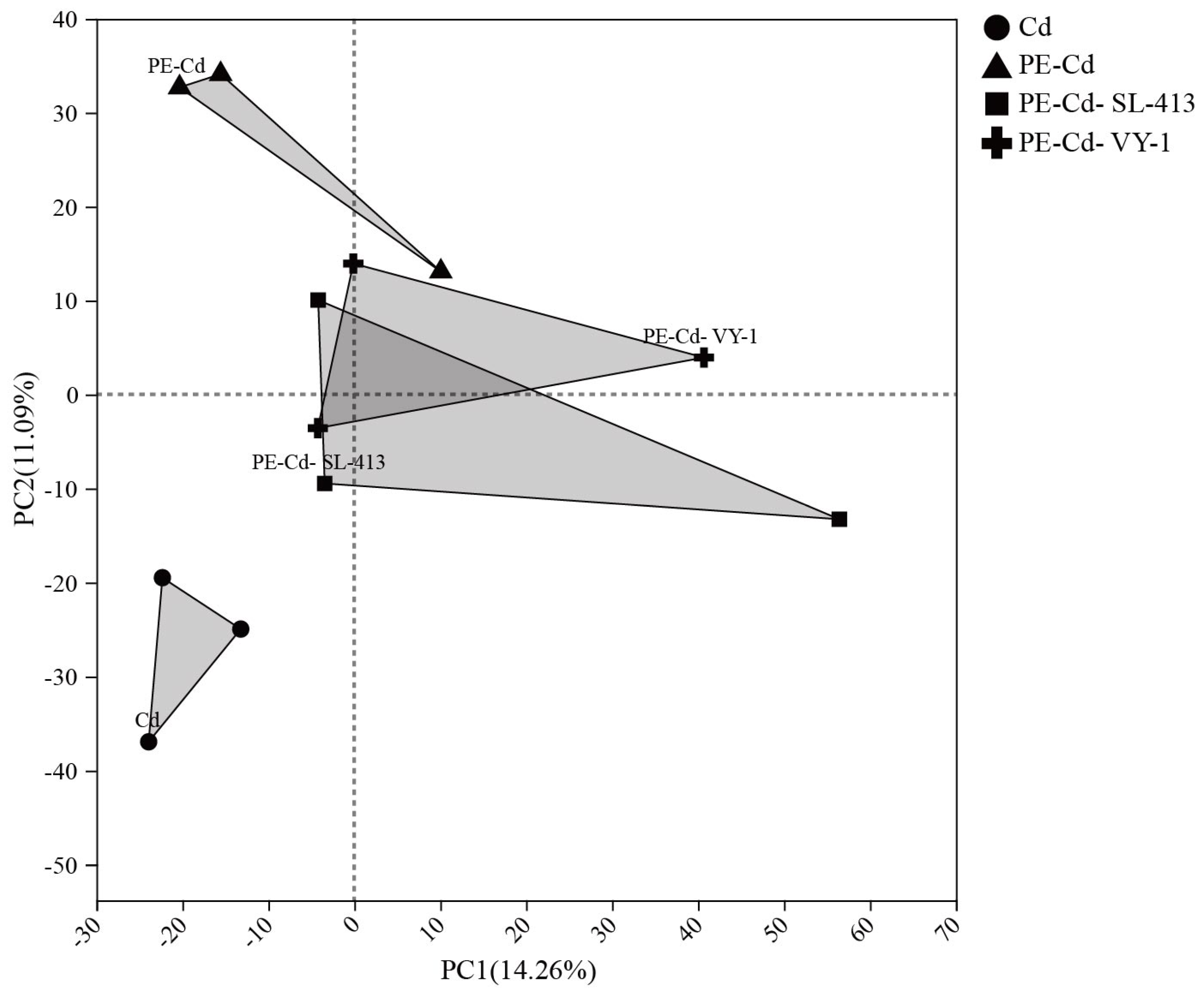
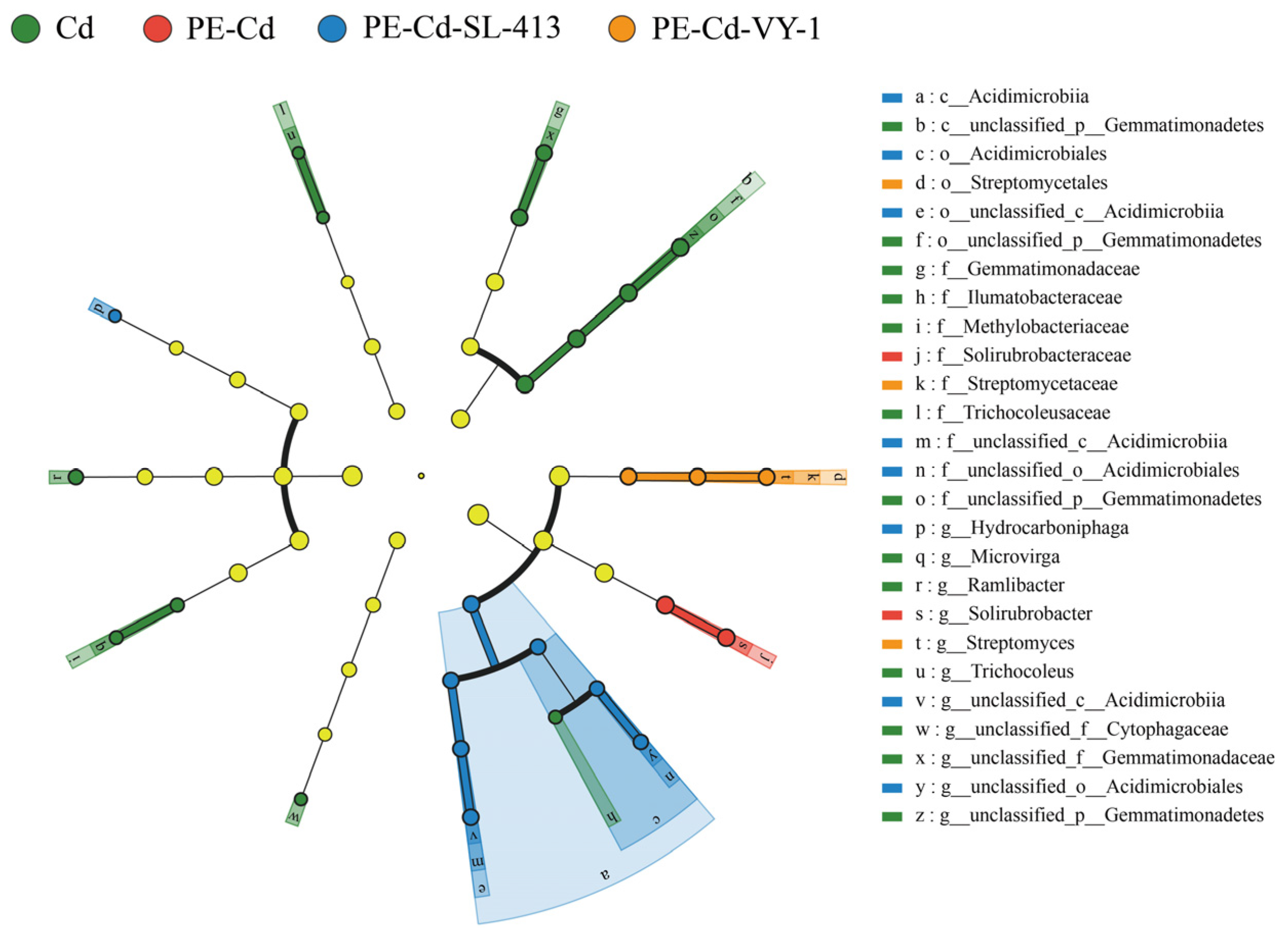
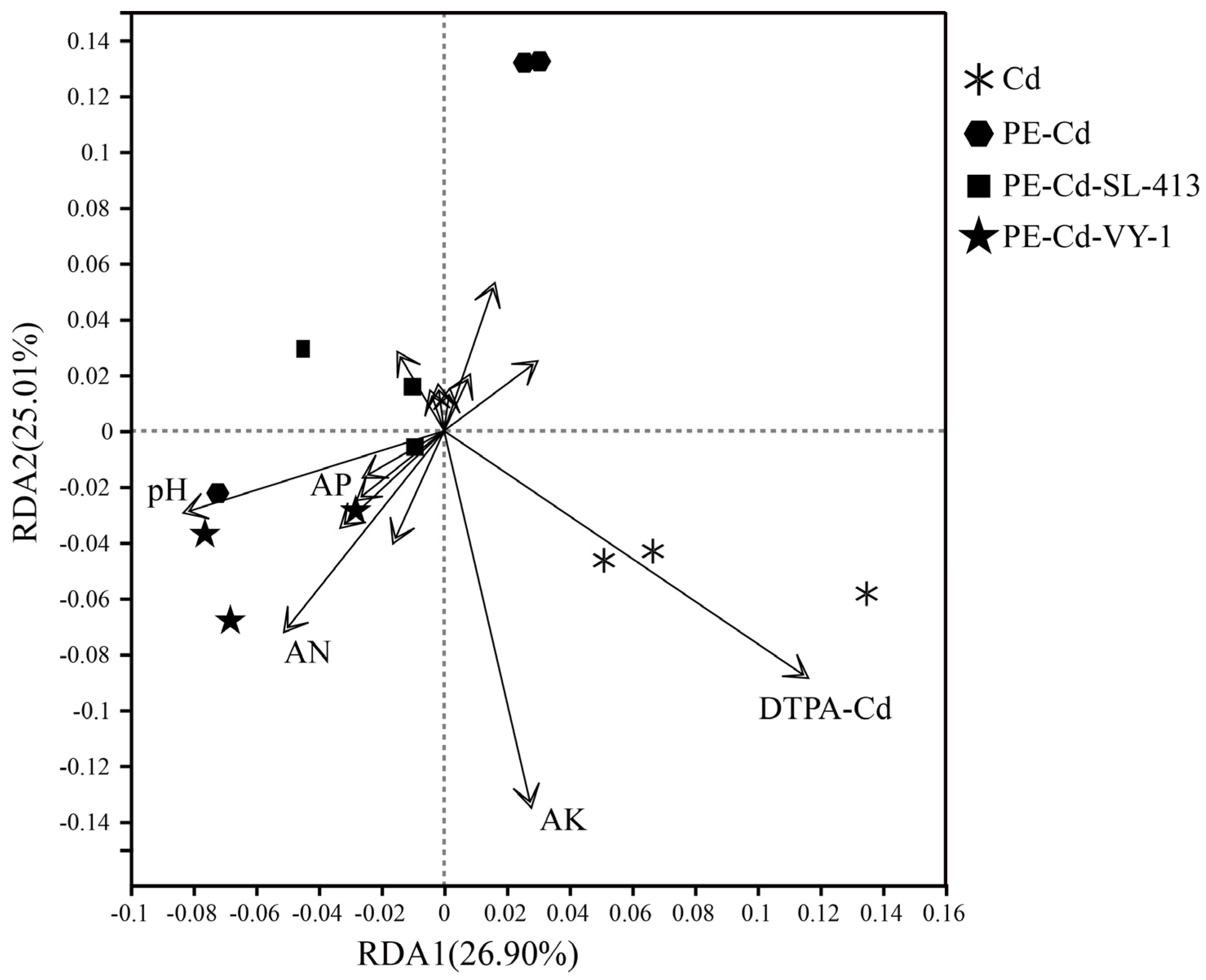
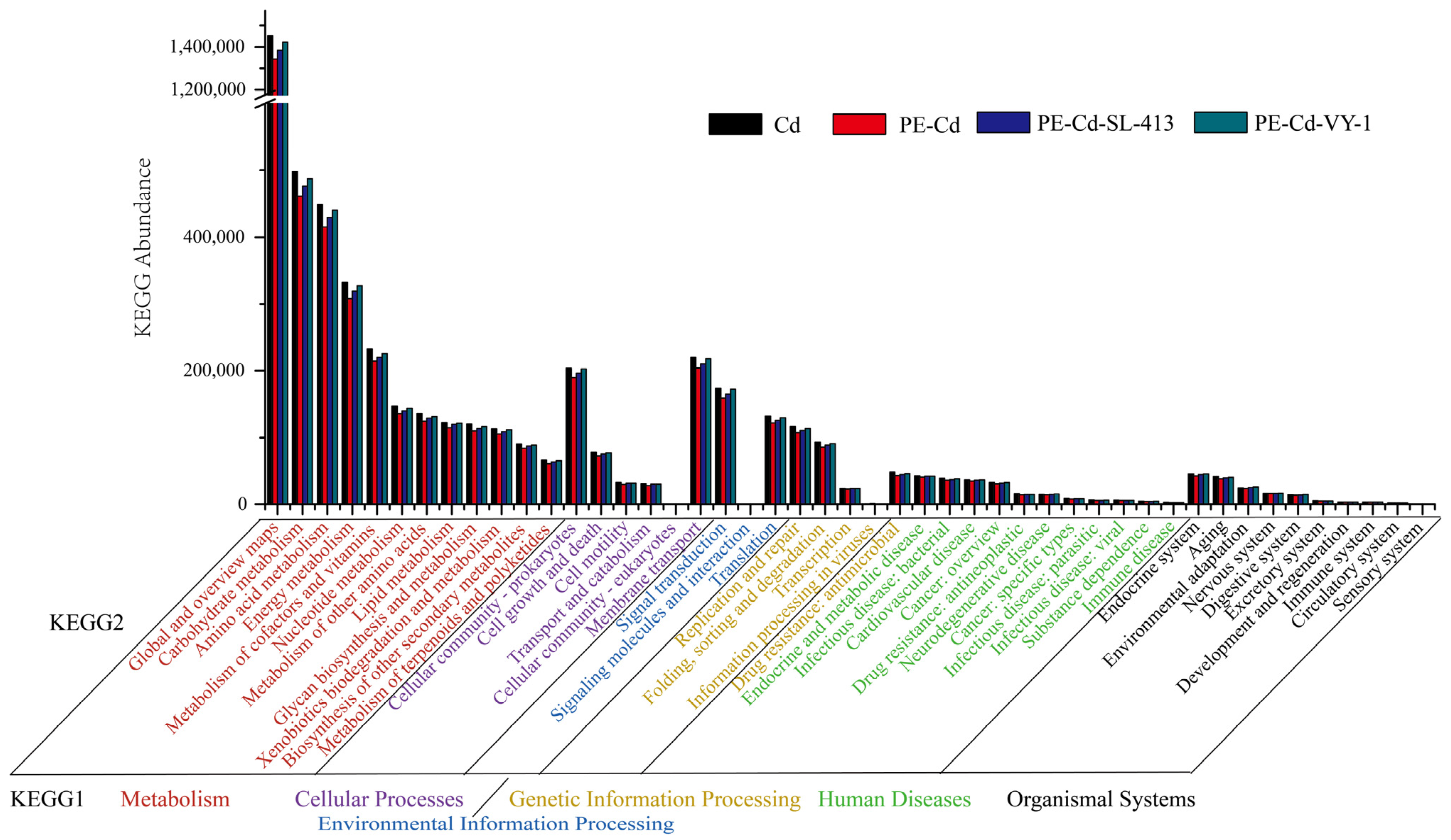
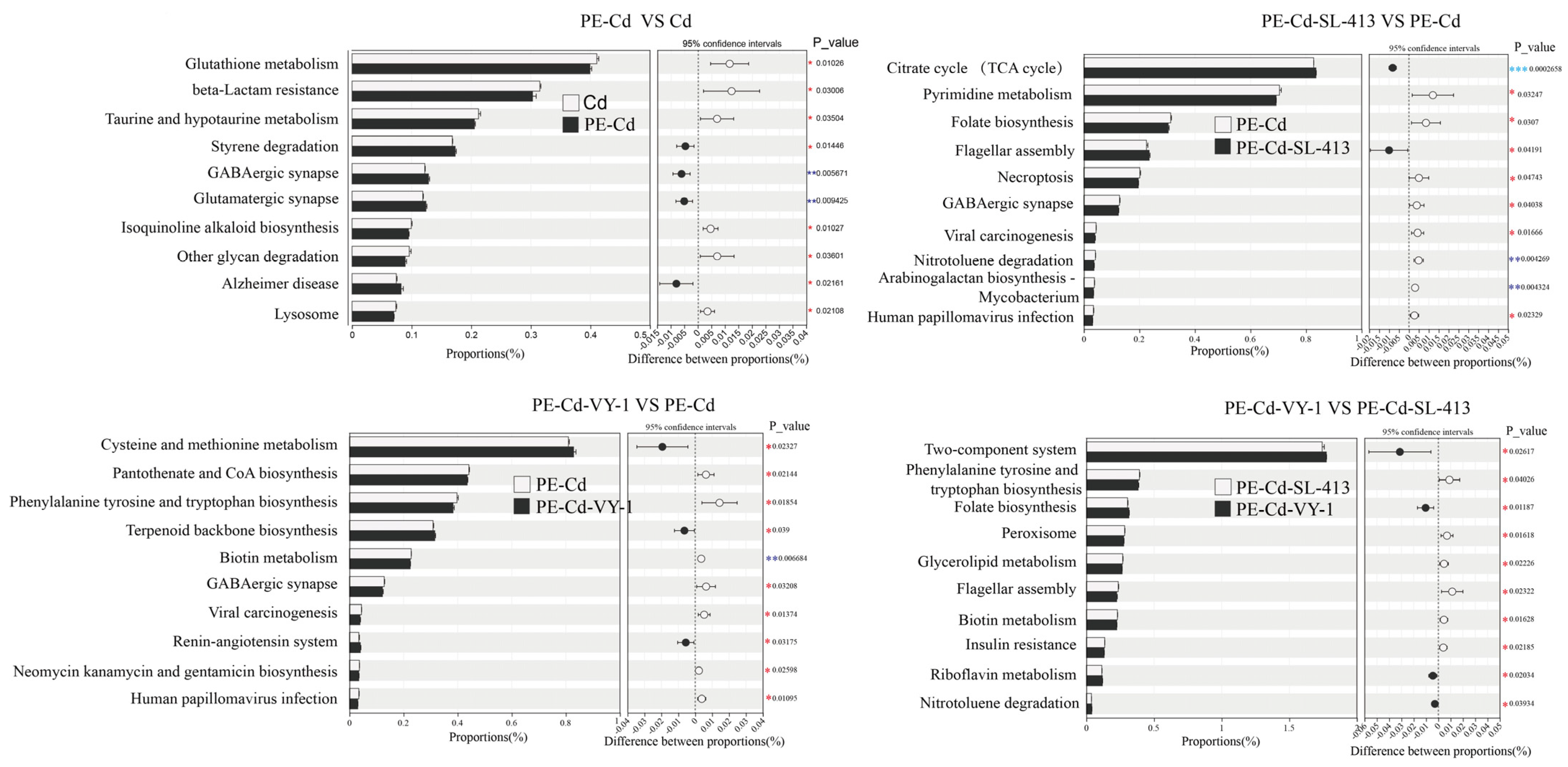
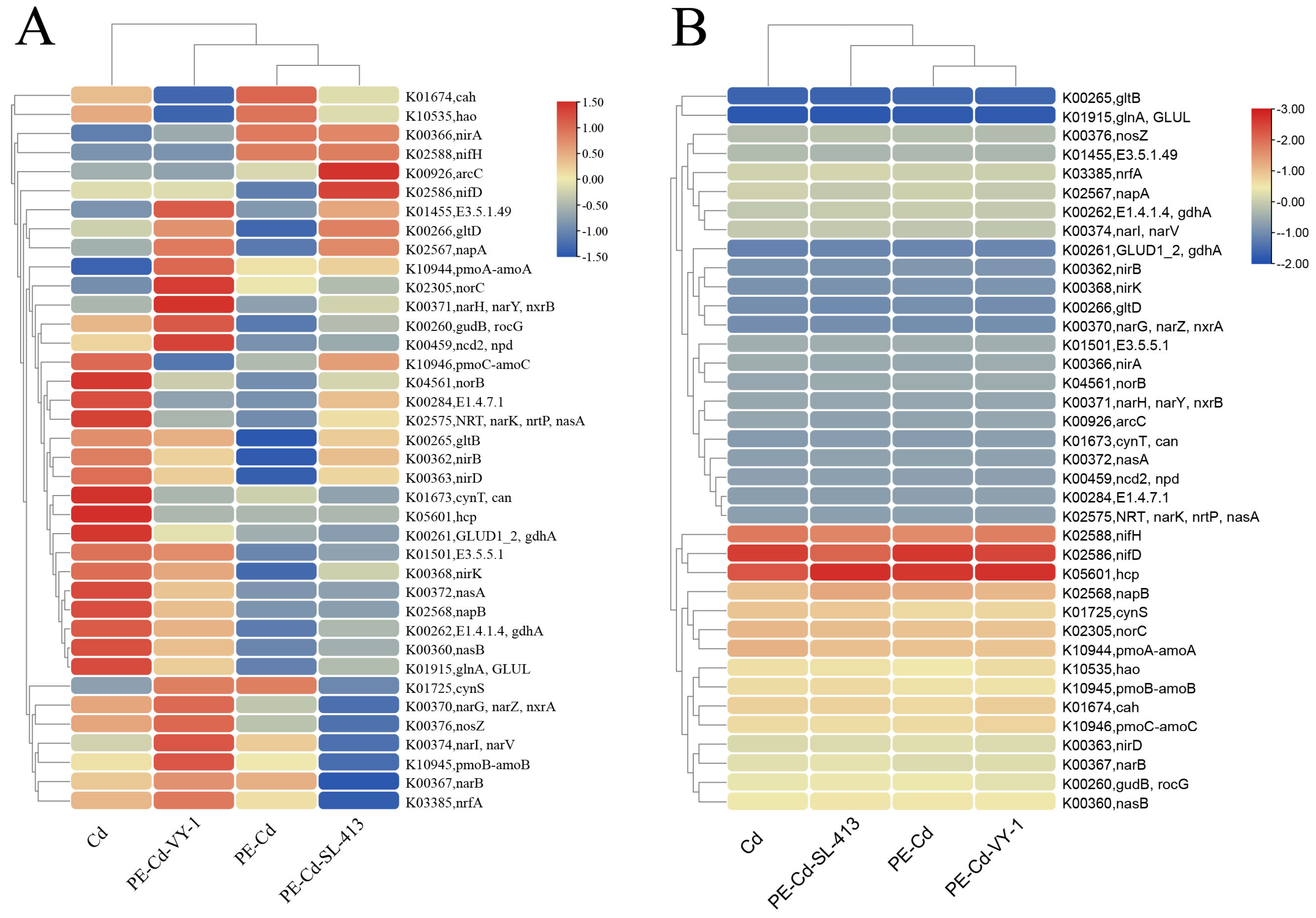
| Experimental Grouping | MPs Class | MPs Particle /μm | MPs Concentration /% | Cd Concentration /(mg·kg−1) | PGPB |
|---|---|---|---|---|---|
| ctrl | - | - | 0 | 0 | - |
| Cd | - | - | 0 | 10 | - |
| PE-Cd | PE | 13 | 0.5 | 10 | - |
| PE-Cd-SL-413 | PE | 13 | 0.5 | 10 | Bacillus sp. SL-413 |
| PE-Cd-VY-1 | PE | 13 | 0.5 | 10 | Enterobacter sp. VY-1 |
| Treatment | pH | AK (mg·kg−1) | AP (mg·kg−1) | AN (mg·kg−1) | DTPA-Cd (mg·kg−1) |
|---|---|---|---|---|---|
| ctrl | 6.52 ± 0.1 a | 84.93 ± 1.33 c | 4.00 ± 0.50 c | 28.47 ± 0.81 e | - |
| Cd | 6.14 ± 0.11 b | 73.90 ± 0.52 b | 3.20 ± 0.10 a | 17.27 ± 0.81 b | 4.84 ± 0.12 d |
| PE-Cd | 6.14 ± 0.01 b | 70.93 ± 0.57 a | 3.03 ± 0.12 a | 13.07 ± 0.81 a | 3.89 ± 0.12 b |
| PE-Cd-SL-413 | 6.14 ± 0.05 b | 73.47 ± 0.74 b | 3.53 ± 0.55 ab | 22.87 ± 1.62 d | 3.55 ± 0.06 a |
| PE-Cd-VY-1 | 6.20 ± 0.08 b | 73.33 ± 2.18 b | 3.37 ± 0.38 ab | 20.07 ± 0.81 c | 4.18 ± 0.07 c |
Disclaimer/Publisher’s Note: The statements, opinions and data contained in all publications are solely those of the individual author(s) and contributor(s) and not of MDPI and/or the editor(s). MDPI and/or the editor(s) disclaim responsibility for any injury to people or property resulting from any ideas, methods, instructions or products referred to in the content. |
© 2025 by the authors. Licensee MDPI, Basel, Switzerland. This article is an open access article distributed under the terms and conditions of the Creative Commons Attribution (CC BY) license (https://creativecommons.org/licenses/by/4.0/).
Share and Cite
Chen, Y.; Liu, H.; Sun, Y.-B.; Wang, M.; Meng, Y.-L.; Liu, Y.-Q.; Ren, X.-M.; Li, B.-L.L.; Han, X.-M.; Liu, L.; et al. Regulatory Mechanisms of Plant Growth-Promoting Bacteria in Alleviating Microplastic and Heavy Metal Combined Pollution: Insights from Plant Growth and Metagenomic Analysis. Agronomy 2025, 15, 2168. https://doi.org/10.3390/agronomy15092168
Chen Y, Liu H, Sun Y-B, Wang M, Meng Y-L, Liu Y-Q, Ren X-M, Li B-LL, Han X-M, Liu L, et al. Regulatory Mechanisms of Plant Growth-Promoting Bacteria in Alleviating Microplastic and Heavy Metal Combined Pollution: Insights from Plant Growth and Metagenomic Analysis. Agronomy. 2025; 15(9):2168. https://doi.org/10.3390/agronomy15092168
Chicago/Turabian StyleChen, Yan, Han Liu, Yu-Bo Sun, Meng Wang, Yue-Liang Meng, Yong-Qi Liu, Xue-Min Ren, Bai-Lian Larry Li, Xue-Mei Han, Ling Liu, and et al. 2025. "Regulatory Mechanisms of Plant Growth-Promoting Bacteria in Alleviating Microplastic and Heavy Metal Combined Pollution: Insights from Plant Growth and Metagenomic Analysis" Agronomy 15, no. 9: 2168. https://doi.org/10.3390/agronomy15092168
APA StyleChen, Y., Liu, H., Sun, Y.-B., Wang, M., Meng, Y.-L., Liu, Y.-Q., Ren, X.-M., Li, B.-L. L., Han, X.-M., Liu, L., & Chen, Z.-J. (2025). Regulatory Mechanisms of Plant Growth-Promoting Bacteria in Alleviating Microplastic and Heavy Metal Combined Pollution: Insights from Plant Growth and Metagenomic Analysis. Agronomy, 15(9), 2168. https://doi.org/10.3390/agronomy15092168






